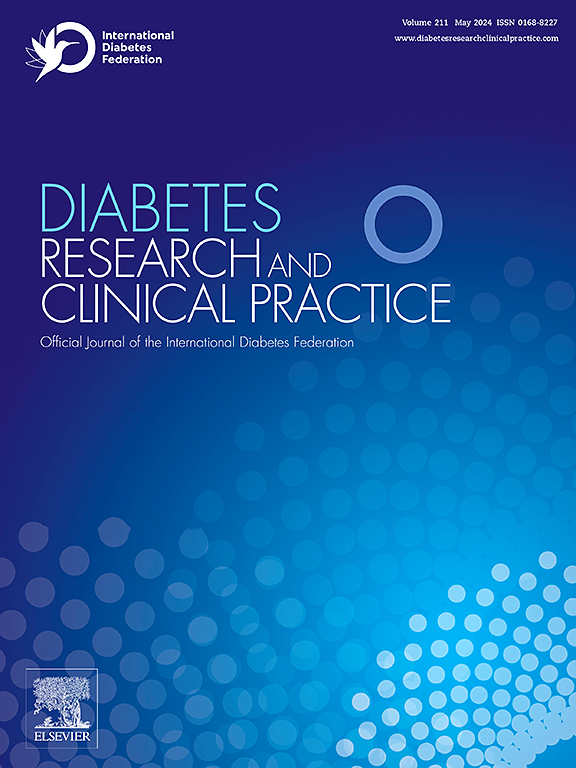Analysis of the global burden of CKD-T2DM in young and middle-aged adults in 204 countries and territories from 2000 to 2019: A systematic study of the global burden of disease in 2019
IF 7.4
3区 医学
Q1 ENDOCRINOLOGY & METABOLISM
引用次数: 0
Abstract
Background
Diabetes stands as a principal risk factor for severe complications including renal and cardiovascular diseases. The gradual rise in type 2 diabetes cases globally, coupled with a trend towards younger demographics, has led to an escalating prevalence of chronic kidney disease. However, its etiology is multifaceted, necessitating individualized treatment and refinement, particularly crucial in screening and managing the burden of CKD-T2DM. A comprehensive analysis of CKD-T2DM burden at global, regional, and national levels from 2000 to 2019, based on the latest data, can inform screening, early diagnostics, and treatment strategies, thereby optimizing healthcare resource allocation.
Methods
Utilizing data sourced from the Global Burden of Disease (GBD) database, we delineated the incidence, mortality, and DALYs rates of CKD-T2DM from 2000 to 2019 across global, regional, and national scales. We summarized the age-standardized incidence rate (ASIR), age-standardized mortality rate (ASMR), and age-standardized death rate (ASDR) of CKD-T2DM globally, regionally, and nationally, presenting them visually. Moreover, we calculated and visually depicted the estimated annual percentage change (EAPC) of various CKD-T2DM indicators at these levels. Additionally, CKD-T2DM patients were stratified by age to compare the age distribution of patient deaths and the age burden between 2000 and 2019.
Findings
The disease burden of CKD-T2DM among young and middle-aged individuals globally has shown a sustained increase from 2000 to 2019. Incidence, mortality, and DALYs rates have exhibited an overall upward trend, with males showing higher rates compared to females. Significant disparities exist among different countries and regions, with India, China, and Mexico emerging as the countries with the highest number of new cases. Nicaragua, Mexico, and the United Arab Emirates have the highest age-standardized incidence rates, whereas Uganda, Ethiopia, and Burundi have the lowest. At the age level, the burden of CKD-T2DM exhibits varying trends among different age groups but generally shows an upward trajectory, particularly in the 45–49 age bracket. High systolic blood pressure and high BMI stand as the primary contributing factors to mortality and DALYs, with variations in their influence observed across different regions and levels of development.
Interpretation
ver the past 20 years, the burden of CKD-T2DM among young and middle-aged individuals globally has continued to increase, with disparities existing among different countries, regions, and age groups, but overall showing an upward trend. The reasons for this trend are multifaceted, including global lifestyle changes such as dietary shifts, sedentary lifestyles, obesity, as well as population aging and inadequate preventive measures in certain regions. Addressing these challenges necessitates optimizing screening methods, adjusting lifestyles, enhancing management strategies, improving medical care and awareness levels, particularly intensifying awareness and screening efforts among males, reinforcing prevention and control measures for the 45–49 age group, enhancing infrastructure and healthcare resources in developing countries, fostering international collaboration, and implementing context-specific measures.
2000 年至 2019 年 204 个国家和地区中青年 CKD-T2DM 全球负担分析:2019 年全球疾病负担系统研究。
背景:糖尿病是导致包括肾脏和心血管疾病在内的严重并发症的主要风险因素。全球 2 型糖尿病病例逐渐增多,加上人口结构年轻化的趋势,导致慢性肾病发病率不断攀升。然而,慢性肾脏病的病因是多方面的,需要进行个体化治疗和完善,这对筛查和管理 CKD-T2DM 的负担尤为重要。根据最新数据对 2000 年至 2019 年全球、地区和国家层面的 CKD-T2DM 负担进行全面分析,可为筛查、早期诊断和治疗策略提供依据,从而优化医疗资源分配:利用来自全球疾病负担(GBD)数据库的数据,我们描述了 2000 年至 2019 年全球、地区和国家范围内 CKD-T2DM 的发病率、死亡率和 DALYs 率。我们总结了全球、地区和国家范围内 CKD-T2DM 的年龄标准化发病率(ASIR)、年龄标准化死亡率(ASMR)和年龄标准化死亡率(ASDR),并将其直观地呈现出来。此外,我们还计算并直观地描述了 CKD-T2DM 各项指标在这些层面上的估计年度百分比变化(EAPC)。此外,我们还按年龄对 CKD-T2DM 患者进行了分层,以比较 2000 年至 2019 年间患者死亡的年龄分布和年龄负担:研究结果:从 2000 年到 2019 年,全球中青年 CKD-T2DM 疾病负担呈持续上升趋势。发病率、死亡率和残疾调整寿命年数总体呈上升趋势,男性发病率高于女性。不同国家和地区之间存在显著差异,印度、中国和墨西哥成为新增病例数最多的国家。尼加拉瓜、墨西哥和阿拉伯联合酋长国的年龄标准化发病率最高,而乌干达、埃塞俄比亚和布隆迪的发病率最低。在年龄层面,不同年龄组的 CKD-T2DM 负担呈现出不同的趋势,但总体上呈上升趋势,尤其是在 45-49 岁年龄段。高收缩压和高体重指数是导致死亡率和残疾调整寿命年数的主要因素,其影响在不同地区和发展水平之间存在差异。解读:过去 20 年来,全球中青年的 CKD-T2DM 负担持续增加,不同国家、地区和年龄组之间存在差异,但总体呈上升趋势。造成这一趋势的原因是多方面的,包括全球生活方式的改变,如饮食结构的改变、久坐不动的生活方式、肥胖,以及人口老龄化和某些地区预防措施不足。要应对这些挑战,就必须优化筛查方法,调整生活方式,加强管理策略,提高医疗保健和认识水平,特别是加强男性的认识和筛查工作,加强 45-49 岁年龄组的预防和控制措施,加强发展中国家的基础设施和医疗保健资源,促进国际合作,并实施针对具体情况的措施。
本文章由计算机程序翻译,如有差异,请以英文原文为准。
求助全文
约1分钟内获得全文
求助全文
来源期刊

Diabetes research and clinical practice
医学-内分泌学与代谢
CiteScore
10.30
自引率
3.90%
发文量
862
审稿时长
32 days
期刊介绍:
Diabetes Research and Clinical Practice is an international journal for health-care providers and clinically oriented researchers that publishes high-quality original research articles and expert reviews in diabetes and related areas. The role of the journal is to provide a venue for dissemination of knowledge and discussion of topics related to diabetes clinical research and patient care. Topics of focus include translational science, genetics, immunology, nutrition, psychosocial research, epidemiology, prevention, socio-economic research, complications, new treatments, technologies and therapy.
 求助内容:
求助内容: 应助结果提醒方式:
应助结果提醒方式:


